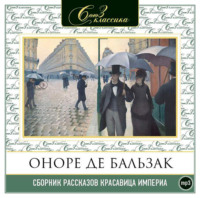 полная версия
полная версияThe Lesser Bourgeoisie

Honoré de Balzac
The Lesser Bourgeoisie
Here, madame, is one of those books which come into the mind, whence no one knows, giving pleasure to the author before he can foresee what reception the public, our great present judge, will accord to it. Feeling almost certain of your sympathy in my pleasure, I dedicate the book to you. Ought it not to belong to you as the tithe formerly belonged to the Church in memory of God, who makes all things bud and fruit in the fields and in the intellect?
A few lumps of clay, left by Moliere at the feet of his colossal statue of Tartuffe, have here been kneaded by a hand more daring than able; but, at whatever distance I may be from the greatest of comic writers, I shall still be glad to have used these crumbs in showing the modern Hypocrite in action. The chief encouragement that I have had in this difficult undertaking was in finding it apart from all religious questions, – questions which ought to be kept out of it for the sake of one so pious as yourself; and also because of what a great writer has lately called our present “indifference in matters of religion.”
May the double signification of your names be for my book a prophecy! Deign to find here the respectful gratitude of him who ventures to call himself the most devoted of your servants.
De Balzac.PART I. THE LESSER BOURGEOIS OF PARIS
CHAPTER I. DEPARTING PARIS
The tourniquet Saint-Jean, the narrow passage entered through a turnstile, a description of which was said to be so wearisome in the study entitled “A Double Life” (Scenes from Private Life), that naive relic of old Paris, has at the present moment no existence except in our said typography. The building of the Hotel-de-Ville, such as we now see it, swept away a whole section of the city.
In 1830, passers along the street could still see the turnstile painted on the sign of a wine-merchant, but even that house, its last asylum, has been demolished. Alas! old Paris is disappearing with frightful rapidity. Here and there, in the course of this history of Parisian life, will be found preserved, sometimes the type of the dwellings of the middle ages, like that described in “Fame and Sorrow” (Scenes from Private Life), one or two specimens of which exist to the present day; sometimes a house like that of Judge Popinot, rue du Fouarre, a specimen of the former bourgeoisie; here, the remains of Fulbert’s house; there, the old dock of the Seine as it was under Charles IX. Why should not the historian of French society, a new Old Mortality, endeavor to save these curious expressions of the past, as Walter Scott’s old man rubbed up the tombstones? Certainly, for the last ten years the outcries of literature in this direction have not been superfluous; art is beginning to disguise beneath its floriated ornaments those ignoble facades of what are called in Paris “houses of product,” which one of our poets has jocosely compared to chests of drawers.
Let us remark here, that the creation of the municipal commission “del ornamento” which superintends at Milan the architecture of street facades, and to which every house owner is compelled to subject his plan, dates from the seventeenth century. Consequently, we see in that charming capital the effects of this public spirit on the part of nobles and burghers, while we admire their buildings so full of character and originality. Hideous, unrestrained speculation which, year after year, changes the uniform level of storeys, compresses a whole apartment into the space of what used to be a salon, and wages war upon gardens, will infallibly react on Parisian manners and morals. We shall soon be forced to live more without than within. Our sacred private life, the freedom and liberty of home, where will they be? – reserved for those who can muster fifty thousand francs a year! In fact, few millionaires now allow themselves the luxury of a house to themselves, guarded by a courtyard on a street and protected from public curiosity by a shady garden at the back.
By levelling fortunes, that section of the Code which regulates testamentary bequests, has produced these huge stone phalansteries, in which thirty families are often lodged, returning a rental of a hundred thousand francs a year. Fifty years hence we shall be able to count on our fingers the few remaining houses which resemble that occupied, at the moment our narrative begins, by the Thuillier family, – a really curious house which deserves the honor of an exact description, if only to compare the life of the bourgeoisie of former times with that of to-day.
The situation and the aspect of this house, the frame of our present Scene of manners and morals, has, moreover, a flavor, a perfume of the lesser bourgeoisie, which may attract or repel attention according to the taste of each reader.
In the first place, the Thuillier house did not belong to either Monsieur or Madame Thuillier, but to Mademoiselle Thuillier, the sister of Monsieur Thuillier.
This house, bought during the first six months which followed the revolution of July by Mademoiselle Marie-Jeanne-Brigitte Thuillier, a spinster of full age, stands about the middle of the rue Saint-Dominique d’Enfer, to the right as you enter by the rue d’Enfer, so that the main building occupied by Monsieur Thuillier faces south.
The progressive movement which is carrying the Parisian population to the heights along the right bank of the Seine had long injured the sale of property in what is called the “Latin quarter,” when reasons, which will be given when we come to treat of the character and habits of Monsieur Thuillier, determined his sister to the purchase of real estate. She obtained this property for the small sum of forty-six thousand francs; certain extras amounted to six thousand more; in all, the price paid was fifty-two thousand francs. A description of the property given in the style of an advertisement, and the results obtained by Monsieur Thuillier’s exertions, will explain by what means so many fortunes increased enormously after July, 1830, while so many others sank.
Toward the street the house presents a facade of rough stone covered with plaster, cracked by weather and lined by the mason’s instrument into a semblance of blocks of cut stone. This frontage is so common in Paris and so ugly that the city ought to offer premiums to house-owners who would build their facades of cut-stone blocks. Seven windows lighted the gray front of this house which was raised three storeys, ending in a mansard roof covered with slate. The porte-cochere, heavy and solid, showed by its workmanship and style that the front building on the street had been erected in the days of the Empire, to utilize a part of the courtyard of the vast old mansion, built at an epoch when the quarter d’Enfer enjoyed a certain vogue.
On one side was the porter’s lodge; on the other the staircase of the front building. Two wings, built against the adjoining houses, had formerly served as stables, coach-house, kitchen and offices to the rear dwelling; but since 1830, they had been converted into warerooms. The one on the right was let to a certain M. Metivier, jr., wholesale dealer in paper; that on the left to a bookseller named Barbet. The offices of each were above the warerooms; the bookseller occupying the first storey, and the paper-dealer the second storey of the house on the street. Metivier, jr., who was more of a commission merchant in paper than a regular dealer, and Barbet, much more of a money lender and discounter than a bookseller, kept these vast warerooms for the purpose of storing, – one, his stacks of paper, bought of needy manufacturers, the other, editions of books given as security for loans.
The shark of bookselling and the pike of paper-dealing lived on the best of terms, and their mutual operations, exempt from the turmoil of retail business, brought so few carriages into that tranquil courtyard that the concierge was obliged to pull up the grass between the paving stones. Messrs. Barbet and Metivier paid a few rare visits to their landlords, and the punctuality with which they paid their rent classed them as good tenants; in fact, they were looked upon as very honest men by the Thuillier circle.
As for the third floor on the street, it was made into two apartments; one of which was occupied by M. Dutocq, clerk of the justice of peace, a retired government employee, and a frequenter of the Thuillier salon; the other by the hero of this Scene, about whom we must content ourselves at the present moment by fixing the amount of his rent, – namely, seven hundred francs a year, – and the location he had chosen in the heart of this well-filled building, exactly three years before the curtain rises on the present domestic drama.
The clerk, a bachelor of fifty, occupied the larger of the two apartments on the third floor. He kept a cook, and the rent of the rooms was a thousand francs a year. Within two years of the time of her purchase, Mademoiselle Thuillier was receiving seven thousand two hundred francs in rentals, for a house which the late proprietor had supplied with outside blinds, renovated within, and adorned with mirrors, without being able to sell or let it. Moreover, the Thuilliers themselves, nobly lodged, as we shall see, enjoyed also a fine garden, – one of the finest in that quarter, – the trees of which shaded the lonely little street named the rue Neuve-Saint-Catherine.
Standing between the courtyard and the garden, the main building, which they inhabited, seems to have been the caprice of some enriched bourgeois in the reign of Louis XIV.; the dwelling, perhaps, of a president of the parliament, or that of a tranquil savant. Its noble free-stone blocks, damaged by time, have a certain air of Louis-the-Fourteenth grandeur; the courses of the facade define the storeys; panels of red brick recall the appearance of the stables at Versailles; the windows have masks carved as ornaments in the centre of their arches and below their sills. The door, of small panels in the upper half and plain below, through which, when open, the garden can be seen, is of that honest, unassuming style which was often employed in former days for the porter’s lodges of the royal chateaux.
This building, with five windows to each course, rises two storeys above the ground-floor, and is particularly noticeable for a roof of four sides ending in a weather-vane, and broken here and there by tall, handsome chimneys, and oval windows. Perhaps this structure is the remains of some great mansion; but after examining all the existing old maps of Paris, we find nothing which bears out this conjecture. Moreover, the title-deeds of property under Louis XIV. was Petitot, the celebrated painter in miniature, who obtained it originally from President Lecamus. We may therefore believe that Lecamus lived in this building while he was erecting his more famous mansion in the rue de Thorigny.
So Art and the legal robe have passed this way in turn. How many instigations of needs and pleasures have led to the interior arrangement of the dwelling! To right, as we enter a square hall forming a closed vestibule, rises a stone staircase with two windows looking on the garden. Beneath the staircase opens a door to the cellar. From this vestibule we enter the dining-room, lighted from the courtyard, and the dining-room communicates at its side with the kitchen, which forms a continuation of the wing in which are the warerooms of Metivier and Barbet. Behind the staircase extends, on the garden side, a fine study or office with two large windows. The first and second floor form two complete apartments, and the servants’ quarters are shown by the oval windows in the four-sided roof.
A large porcelain stove heats the square vestibule, the two glass doors of which, placed opposite to each other, light it. This room, paved in black and white marble, is especially noticeable for a ceiling of beams formerly painted and gilt, but which had since received, probably under the Empire, a coat of plain white paint. The three doors of the study, salon and dining-room, surmounted by oval panels, are awaiting a restoration that is more than needed. The wood-work is heavy, but the ornamentation is not without merit. The salon, panelled throughout, recalls the great century by its tall mantelpiece of Languedoc marble, its ceiling decorated at the corners, and by the style of its windows, which still retain their little panes. The dining-room, communicating with the salon by a double door, is floored with stone; the wood-work is oak, unpainted, and an atrocious modern wall-paper has been substituted for the tapestries of the olden time. The ceiling is of chestnut; and the study, modernized by Thuillier, adds its quota to these discordances.
The white and gold mouldings of the salon are so effaced that nothing remains of the gilding but reddish lines, while the white enamelling is yellow, cracked, and peeling off. Never did the Latin saying “Otium cum dignitate” have a greater commentary to the mind of a poet than in this noble building. The iron-work of the staircase baluster is worthy of the artist and the magistrate; but to find other traces of their taste to-day in this majestic relic, the eyes of an artistic observer are needed.
The Thuilliers and their predecessors have frequently degraded this jewel of the upper bourgeoisie by the habits and inventions of the lesser bourgeoisie. Look at those walnut chairs covered with horse-hair, that mahogany table with its oilcloth cover, that sideboard, also of mahogany, that carpet, bought at a bargain, beneath the table, those metal lamps, that wretched paper with its red border, those execrable engravings, and the calico curtains with red fringes, in a dining-room, where the friends of Petitot once feasted! Do you notice the effect produced in the salon by those portraits of Monsieur and Madame and Mademoiselle Thuillier by Pierre Grassou, the artist par excellence of the modern bourgeoisie. Have you remarked the card-tables and the consoles of the Empire, the tea-table supported by a lyre, and that species of sofa, of gnarled mahogany, covered in painted velvet of a chocolate tone? On the chimney-piece, with the clock (representing the Bellona of the Empire), are candelabra with fluted columns. Curtains of woollen damask, with under-curtains of embroidered muslin held back by stamped brass holders, drape the windows. On the floor a cheap carpet. The handsome vestibule has wooden benches, covered with velvet, and the panelled walls with their fine carvings are mostly hidden by wardrobes, brought there from time to time from the bedrooms occupied by the Thuilliers. Fear, that hideous divinity, has caused the family to add sheet-iron doors on the garden side and on the courtyard side, which are folded back against the walls in the daytime, and are closed at night.
It is easy to explain the deplorable profanation practised on this monument of the private life of the bourgeoisie of the seventeenth century, by the private life of the bourgeoisie of the nineteenth. At the beginning of the Consulate, let us say, some master-mason having bought the ancient building, took the idea of turning to account the ground which lay between it and the street. He probably pulled down the fine porte-cochere or entrance gate, flanked by little lodges which guarded the charming “sejour” (to use a word of the olden time), and proceeded, with the industry of a Parisian proprietor, to impress his withering mark on the elegance of the old building. What a curious study might be made of the successive title-deeds of property in Paris! A private lunatic asylum performs its functions in the rue des Batailles in the former dwelling of the Chevalier Pierre Bayard du Terrail, once without fear and without reproach; a street has now been built by the present bourgeois administration through the site of the hotel Necker. Old Paris is departing, following its kings who abandoned it. For one masterpiece of architecture saved from destruction by a Polish princess (the hotel Lambert, Ile Saint-Louis, bought and occupied by the Princess Czartoriska) how many little palaces have fallen, like this dwelling of Petitot, into the hands of such as Thuillier.
Here follows the causes which made Mademoiselle Thuillier the owner of the house.
CHAPTER II. THE HISTORY OF A TYRANNY
At the fall of the Villele ministry, Monsieur Louis-Jerome Thuillier, who had then seen twenty-six years’ service as a clerk in the ministry of finance, became sub-director of a department thereof; but scarcely had he enjoyed the subaltern authority of a position formerly his lowest hope, when the events of July, 1830, forced him to resign it. He calculated, shrewdly enough, that his pension would be honorably and readily given by the new-comers, glad to have another office at their disposal. He was right; for a pension of seventeen hundred francs was paid to him immediately.
When the prudent sub-director first talked of resigning, his sister, who was far more the companion of his life than his wife, trembled for his future.
“What will become of Thuillier?” was a question which Madame and Mademoiselle Thuillier put to each other with mutual terror in their little lodging on a third floor of the rue d’Argenteuil.
“Securing his pension will occupy him for a time,” Mademoiselle Thuillier said one day; “but I am thinking of investing my savings in a way that will cut out work for him. Yes; it will be something like administrating the finances to manage a piece of property.”
“Oh, sister! you will save his life,” cried Madame Thuillier.
“I have always looked for a crisis of this kind in Jerome’s life,” replied the old maid, with a protecting air.
Mademoiselle Thuillier had too often heard her brother remark: “Such a one is dead; he only survived his retirement two years”; she had too often heard Colleville, her brother’s intimate friend, a government employee like himself, say, jesting on this climacteric of bureaucrats, “We shall all come to it, ourselves,” not to appreciate the danger her brother was running. The change from activity to leisure is, in truth, the critical period for government employees of all kinds.
Those of them who know not how to substitute, or perhaps cannot substitute other occupations for the work to which they have been accustomed, change in a singular manner; some die outright; others take to fishing, the vacancy of that amusement resembling that of their late employment under government; others, who are smarter men, dabble in stocks, lose their savings, and are thankful to obtain a place in some enterprise that is likely to succeed, after a first disaster and liquidation, in the hands of an abler management. The late clerk then rubs his hands, now empty, and says to himself, “I always did foresee the success of the business.” But nearly all these retired bureaucrats have to fight against their former habits.
“Some,” Colleville used to say, “are victims to a sort of ‘spleen’ peculiar to the government clerk; they die of a checked circulation; a red-tapeworm is in their vitals. That little Poiret couldn’t see the well-known white carton without changing color at the beloved sight; he used to turn from green to yellow.”
Mademoiselle Thuillier was considered the moving spirit of her brother’s household; she was not without decision and force of character, as the following history will show. This superiority over those who immediately surrounded her enabled her to judge her brother, although she adored him. After witnessing the failure of the hopes she had set upon her idol, she had too much real maternity in her feeling for him to let herself be mistaken as to his social value.
Thuillier and his sister were children of the head porter at the ministry of finance. Jerome had escaped, thanks to his near-sightedness, all drafts and conscriptions. The father’s ambition was to make his son a government clerk. At the beginning of this century the army presented too many posts not to leave various vacancies in the government offices. A deficiency of minor officials enabled old Pere Thuillier to hoist his son upon the lowest step of the bureaucratic hierarchy. The old man died in 1814, leaving Jerome on the point of becoming sub-director, but with no other fortune than that prospect. The worthy Thuillier and his wife (who died in 1810) had retired from active service in 1806, with a pension as their only means of support; having spent what property they had in giving Jerome the education required in these days, and in supporting both him and his sister.
The influence of the Restoration on the bureaucracy is well known. From the forty and one suppressed departments a crowd of honorable employees returned to Paris with nothing to do, and clamorous for places inferior to those they had lately occupied. To these acquired rights were added those of exiled families ruined by the Revolution. Pressed between the two floods, Jerome thought himself lucky not to have been dismissed under some frivolous pretext. He trembled until the day when, becoming by mere chance sub-director, he saw himself secure of a retiring pension. This cursory view of matters will serve to explain Monsieur Thuillier’s very limited scope and knowledge. He had learned the Latin, mathematics, history, and geography that are taught in schools, but he never got beyond what is called the second class; his father having preferred to take advantage of a sudden opportunity to place him at the ministry. So, while the young Thuillier was making his first records on the Grand-Livre, he ought to have been studying his rhetoric and philosophy.
While grinding the ministerial machine, he had no leisure to cultivate letters, still less the arts; but he acquired a routine knowledge of his business, and when he had an opportunity to rise, under the Empire, to the sphere of superior employees, he assumed a superficial air of competence which concealed the son of a porter, though none of it rubbed into his mind. His ignorance, however, taught him to keep silence, and silence served him well. He accustomed himself to practise, under the imperial regime, a passive obedience which pleased his superiors; and it was to this quality that he owed at a later period his promotion to the rank of sub-director. His routine habits then became great experience; his manners and his silence concealed his lack of education, and his absolute nullity was a recommendation, for a cipher was needed. The government was afraid of displeasing both parties in the Chamber by selecting a man from either side; it therefore got out of the difficulty by resorting to the rule of seniority. That is how Thuillier became sub-director. Mademoiselle Thuillier, knowing that her brother abhorred reading, and could substitute no business for the bustle of a public office, had wisely resolved to plunge him into the cares of property, into the culture of a garden, in short, into all the infinitely petty concerns and neighborhood intrigues which make up the life of the bourgeoisie.
The transplanting of the Thuillier household from the rue d’Argenteuil to the rue Saint-Dominique d’Enfer, the business of making the purchase, of finding a suitable porter, and then of obtaining tenants occupied Thuillier from 1831 to 1832. When the phenomenon of the change was accomplished, and the sister saw that Jerome had borne it fairly well, she found him other cares and occupations (about which we shall hear later), all based upon the character of the man himself, as to which it will now be useful to give information.
Though the son of a ministerial porter, Thuillier was what is called a fine man, slender in figure, above middle height, and possessing a face that was rather agreeable if wearing his spectacles, but frightful without them; which is frequently the case with near-sighted persons; for the habit of looking through glasses has covered the pupils of his eyes with a sort of film.
Between the ages of eighteen and thirty, young Thuillier had much success among women, in a sphere which began with the lesser bourgeois and ended in that of the heads of departments. Under the Empire, war left Parisian society rather denuded of men of energy, who were mostly on the battlefield; and perhaps, as a great physician has suggested, this may account for the flabbiness of the generation which occupies the middle of the nineteenth century.
Thuillier, forced to make himself noticeable by other charms than those of mind, learned to dance and to waltz in a way to be cited; he was called “that handsome Thuillier”; he played billiards to perfection; he knew how to cut out likenesses in black paper, and his friend Colleville coached him so well that he was able to sing all the ballads of the day. These various small accomplishments resulted in that appearance of success which deceives youth and befogs it about the future. Mademoiselle Thuillier, from 1806 to 1814, believed in her brother as Mademoiselle d’Orleans believed in Louis-Philippe. She was proud of Jerome; she expected to see him the director-general of his department of the ministry, thanks to his successes in certain salons, where, undoubtedly, he would never have been admitted but for the circumstances which made society under the Empire a medley.








